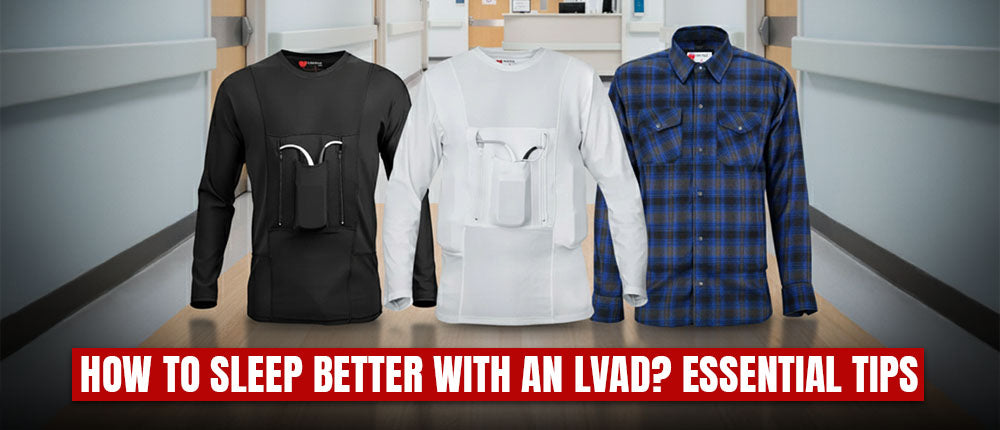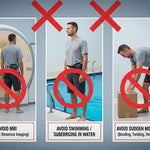
How to Sleep Better with an LVAD? Essential Tips
Deciding to live with an LVAD is no easy choice, as it comes with a whole new lifestyle. Although LVAD is a life-supporting device and greatly improves your quality of life, you need necessary adjustments to live with it.
Many patients struggle with the challenges of living with an LVAD, such as anxiety about keeping it safe and living in a constant fear of adjustment. One important thing that no one talks about enough is the quality of sleep that may be compromised. In fact, it is one of the biggest challenges after LVAD implantation. In this guide, we will discuss how sleep is affected after LVAD and how you can use the right strategies to make it better.
How is sleep quality affected after LVAD?
Imagine you have to live and carry a medical device 24/7 without any break, even when you are sleeping. LVAD components that you need to carry include the controller and batteries. Plus, you need to adjust the driveline. With so many things in mind, your body and mind struggle and live in constant fear that you may accidentally pull the driveline, which can lead to restlessness and poor sleep.
Other than that, the presence of the external device components can make it difficult for you to find a comfortable position to sleep. However, other factors like medications and nutrition can also contribute to poor sleep quality.
Many patients experience insomnia or frequent awakenings due to discomfort and anxiety. However, with the right support of LVAD gear like LVAD Shirts or LVAD Vests, and with some simple lifestyle adjustments, you can sleep better with peace of mind.
Effective Tips to Sleep Better with an LVAD:
The key to sleeping comfortably with an LVAD is finding the right balance between safety and comfort. Here are some tips to help you sleep better.
Get the Right LVAD Support:
When you have the right support, like an LVAD Sleeping belt for HeartMate that keeps your device safe while you are sleeping, you will have less anxiety about keeping it secure. In this way, you can sleep peacefully.
Keep Cables Organized:
Make sure your driveline and wires are organized with the LVAD waist belt and in place so that it reduces the chances of pulling or tangling wires during sleep.
Use Supportive Pillows:
Keeping pillows by your side helps relieve pressure on your abdomen and support your back.
Practice Relaxation Techniques:
Engaging in techniques like deep breathing and meditation can help relieve stress and allow you to relax, especially when done before bed.
Make a Bedtime Routine:
Sleeping and waking up at the same time every single day may help you sleep better, as it helps to stabilize your body’s internal clock.
Avoid Heavy Meals or Caffeine before Bed:
It is best to avoid heavy meals and caffeine intake before bed, as it can affect deep sleep and restful sleep.
How does the right LVAD Gear make a difference?
Do you know that there is the right LVAD apparel specifically designed for every moment of the day? LVAD clothing and accessories have designated pockets and proper channels to keep the controller, batteries, and driveline safe in place. You can make your sleep far more comfortable and stress-free if you know that your device is secured with the right LVAD gear, like an LVAD vest, which is specifically designed with your needs and comfort in mind.
These accessories not only reduce the risk of driveline tugging but also allow you to move more freely without worry. Always choose gear that feels lightweight, breathable, and easy to adjust.
Choose the Right Sleeping Position:
The right sleeping position helps you make yourself comfortable, which allows you to relax and sleep easily. Most doctors recommend sleeping on the back or on the side opposite the driveline exit site. Avoid sleeping on your stomach as it can exert pressure on your driveline and will make you uncomfortable during sleep.
When sleeping on the side, place a small pillow between your knees and another near your abdomen for support. Avoid sleeping directly on the side where your LVAD driveline exits to avoid inconvenience and discomfort.
For better sleep, you can also slightly elevate your upper body using a wedge pillow or adjustable bed. This position helps improve blood circulation and assists in breathing, which keeps you relaxed during sleep.
Additional Tips to Promote Peaceful Sleep:
Here are some of the additional tips for you to promote a restful sleep:
-
Plug in Before Sleeping: You need to plug in your device to a power source because low-battery alarms may not be heard during sleep. So, you need to prepare in case you face any problem.
-
Emergency Backup: Keep a backup of charged batteries and the controller right next to where you are sleeping. Also, keep a flashlight within reach in case you face a power outage.
-
Avoid twisting while turning: Avoid sudden movements like twisting and pulling while turning in the bed, as it can tug on your driveline.
-
Create a comfortable sleep environment: Making the room dark and cool promotes restful sleep. You can also use soft music that helps you sleep better.
-
Stay active during the day: When you stay active in the daytime, like engaging in the activities of daily living or doing light exercises helps regulate sleep patterns.
Seek Professional Help About Sleeping Aids:
If you have tried every tip to improve your sleep but are still struggling to have a good night’s sleep, then you need to talk to your LVAD team or cardiologist and seek professional help. Never try sleeping aids without medical advice, as it may not be suitable for you with this whole heart situation.
Your healthcare provider can recommend safe options, such as certain natural remedies, relaxation therapies, or adjustments in your medication schedule to help you sleep more comfortably.
Final Thoughts:
Although many factors contribute to sleep quality, choosing the right LVAD gear and making smart choices in everyday routine allow peaceful sleep. With the right sleeping position, proper LVAD gear, and mindful bedtime habits, you can create a restful routine that supports both your comfort and safety.
Every patient is unique and experiences different difficulties, but be patient with yourself and learn what works best for you and your body. Once you make a routine that suits you, you will get used to it and will wake up refreshed every single day.
FAQs:
How to sleep with an LVAD?
While sleeping with an LVAD, carry and secure your device with the right support of LVAD gear and help make yourself comfortable so that you can sleep with peace of mind.
What sleeping position is best with an LVAD?
Sleeping on the back or on the side opposite to where your driveline exits is considered the professional’s advice.
Can LVAD patients live alone?
While it is not impossible to live alone with an LVAD, it is better to have a caregiver or family member in close proximity to avoid any inconveniences.
Prev post

What Makes an LVAD Shirt Different from Regular Clothing?
Updated on 28 October 2025
Next post

What Is an LVAD Bag? A Complete Guide for Patients
Updated on 17 October 2025








